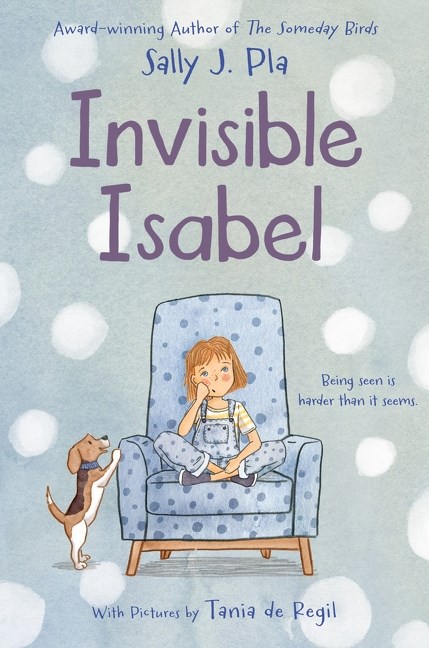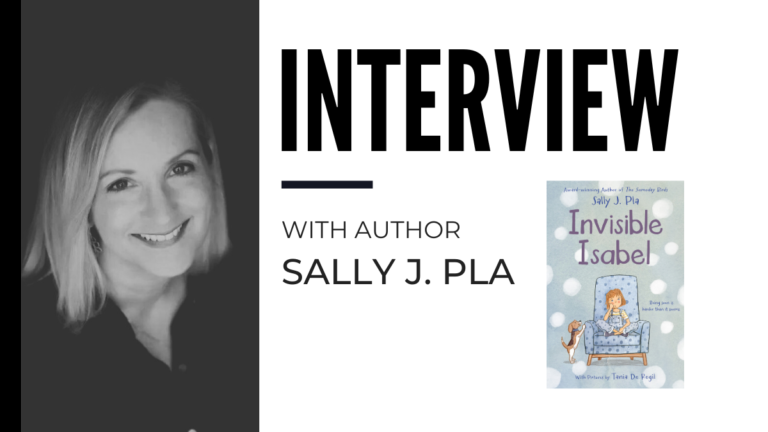An interview about Invisible Isabel with Sally J. Pla and The Children’s Book Review.
This insightful interview with author Sally J. Pla delves into the creation of her latest middle-grade novel, Invisible Isabel.
Pla, known for her acclaimed works that often explore neurodiversity and childhood experiences, discusses the inspiration behind her shy and anxious protagonist, Isabel Beane. Drawing from her own childhood struggles with sensory overwhelm and social anxiety, Pla crafts a relatable character for young readers who may feel invisible or misunderstood.
The interview covers various aspects of the book, including the powerful “worry-moths” metaphor for anxiety, the importance of supportive adults, and the challenges of writing in verse for a younger audience. Pla also shares her hopes for the impact of Isabel’s story on readers and offers advice for children facing similar struggles with anxiety and introversion.
Bianca Schulze: Isabel Beane’s story is not just a tale but a mirror for many introverted children who struggle with anxiety. Were there any specific experiences or individuals from your life that inspired you to create Isabel’s character? How did these experiences or individuals help you understand and portray the concerns of young, introverted readers?

Sally J Pla (SJP): Just like Isabel, my world as a child was filled with Too Muchness. Everything was too bright, too loud, too tight, too confusing. I was aware of EVERYTHING going on around me, especially in the classroom. All the clatter coming from the hall. The hum of the clock, the electricity in the walls, the static flutter of the overhead lights, the overpowering (to me) food smells seeping down the hall at precisely 11:05 each day from the cafeteria.
And the interactions of the other kids were perplexing to me. I didn’t engage. I was afraid of saying or doing something wrong. Like Isabel, I was highly anxious, with constant tummy aches, and terribly shy.
My mother tried to encourage a little extroversion by employing her own homemade 1970s version of implosion therapy: she forced me to engage with the world by doing things like calling up a stranger for information, or go into a shop all alone, to purchase an item for her.
Words cannot express how much I hated this!
Once she made me to go into a donut shop. When I protested and cried, she got very exasperated. “What do you think they’ll do to you in there?” she said, laughing, trying to make light of it. “Do you think they will bite your head off?” So in I went, into the crowded store. The clerk was stressed out and very gruff. He waited for me to order, but I could only stand there, quaking. Finally he shouted: “HEY!! ORDER YOUR DONUTS OR GET OUT OF LINE!”
I got out! Quick! I told my mother, blubbering: “The clerk DID bite my head off!” I was so mad at her! I don’t think that was the life-lesson she’d been hoping to give me.
I was remembering that moment, one day, here in my old age, haha. And laughing a little. And that’s what sparked Isabel.
I wanted to portray not only Isabel’s anxiety, naïveté, and bewilderment by the world, but also that feeling of one’s loved ones just “not getting it”—because this happens so, so much. Parents are well-intentioned. They love. They care. They want to fix. But they do not understand what it feels like to live in a body that’s in a constant-alert state of anxiety and sensory overwhelm.
These feelings are very common feelings for many young kids, not just ones with diagnoses. The difference is just in degree! All kids feel anxiety, shyness, fear. All kids misread social cues sometimes, have friend troubles, stress about their self-worth, their abilities, or whether they’ll miss the bus. Feelings and fears that are often kept inside out of shame or a lack of ability to express or understand them. My goal here was to shine a light, shine a light.
As an autism/neurodiversity advocate with a background in public education, how have your personal experiences and professional journey influenced your approach to writing for middle-grade readers, particularly in addressing topics like anxiety and introversion?
SJP: Since my days working and volunteering in the schools, we’ve seen massive increases in many diagnoses, but anxiety still tends to get underestimated. And anxiety has never been more rampant. Because: what a world it is, out there. And as for introversion: our digital world is turning all of us inward. And yet childhood is THE time to lean outward. To practice and learn social skills for living in a society. I’d argue that building compassion, collaboration, conflict resolution, and confidence is some of the chief work of childhood. I cheer on anything that helps these skills develop in children.
Did you face similar anxieties during your school years, and how did that influence the inclusion of themes like standardized test anxiety in the book?
SJP: Like many kids with different brain wiring, I had a hard time parsing out the proper gist of a question from all the possible ambiguities and variations of meaning within its phrasing. What was the question really asking? I’d agonize, my brain getting lost in forests of potential subtleties of meanings and varying implications of individual words, while the clock ticked.
Today there’s more testing than ever. It’s bonkers. I think the ratio of “time spent teaching” to “time spent testing” is totally out of whack for our teachers.
The metaphor of “worry-moths” is a powerful way to describe Isabel’s anxiety. How did you come up with this imagery, and what do you hope it conveys to young readers?
SJP: The expression, “butterflies in the stomach,” has always seemed far too euphemistic to me. Butterflies are lovely delicate ticklish things, and that’s NOT how anxiety feels! Anxiety is raw and squirmy and sweaty and crampy. It’s beyond butterflies—it’s moths! (And later in the book, when things really ramp up, Isabel even calls her stomach pain “worry-wasps!”)
There’s the “Don’t Raise Your Hand” worry-moth, the “Will You Miss the Bus” worry-moth, the “Did You Forget Your Homework” worry-moth—she has a whole compendium. But I think it’s good that she names her worry-moths. Because naming a fear is often the first step to overcoming it.
In the book, Isabel finds support and understanding from adults like Dr. Hicks and Counselor Wanda. How important was it for you to show positive adult role models who take Isabel’s concerns seriously and help her find accommodations?
SJP: Absolutely critical. There are good adults out there who can help! Even Isabel’s parents, who are distracted and overwhelmed and ignore her needs through most of the story, are loving, well-intentioned parents who are overwhelmed by life’s demands and just need a wake-up call.
In families and schools, the squeaky wheels get all the attention. The quietly-suffering kids who don’t speak up? They become invisible.
As Isabel navigates her worries and the challenges of a new, not-so-nice classmate, she learns to speak up for herself. Are there any specific coping strategies or techniques you wish to convey through the story?
SJP: The end of this story has a whole printed list of simple coping strategies that Isabel and her parents and teachers come up with—techniques and activities any family or classroom group can use. And when it comes to dealing with a hurtful classmate or a bully, allies help. When all the other kids finally start to “see” Isabel through her own acts of kindness toward them, this helps her gain self-confidence.
But this isn’t a didactic “how to” story. It’s just a simple, easy-to-read story-in-verse with sweet illustrations about a girl slowly learning that who she is and how she is, is 100% lovely and fine.
What advice would you give young readers struggling with feeling invisible or overwhelmed by their worries like Isabel? Is there any advice you wish you had received when you were a child facing similar struggles?
SJP: When you are young and small, it sometimes feels like you’re all alone, and that no one has EVER had this problem before you. But, of course, you’re not alone. It’s hard to get up the courage to confide in your trusted others.
If they don’t seem to hear you, keep trying. It is so hard, I know, and I am so sorry to say it, but the main thing is to trust yourself and trust your voice and know your self-worth. Practice communicating your feelings as best you can. Sometimes, the mere act of expressing oneself—confiding to another, or writing, or drawing, however it is—can make you feel so much better. Talking it through with someone who actually listens is best of all.
Isabel’s family plays a significant role in the story, with their “too much-ness” contrasting with Isabel’s introverted nature. How did your own family experiences shape the dynamics in the Beane household?
SJP: I did not grow up in a busy noisy household like the Beanes, but our house would fill with Too-Muchness was during big family parties. Then, the house would ring with Too-Muchness and you could find me in my closet, hiding!
Tania de Regil’s illustrations add a delightful visual element to the story. What do you feel the illustrations bring to the narrative?
SJP: Tania’s illustrations bring such a sweetness and gentleness to the story! I adore her art. I must admit, when I first wrote Isabel, I’d imagined in my head a much darker, Edward Gorey-esque kind of illustrative accompaniment to the text—all rather wicked and tongue-in-cheek. But the minute I saw Tania’s lovely work, I couldn’t imagine the story any other way. And the cover! We told Tania to “use soft colors, and show a shy, receding, invisible-ish girl . . . but make it eye catching!” Ha! Quite the tall order. And she accomplished it utterly beautifully!
You’ve written several acclaimed middle-grade novels. How was the experience of writing Invisible Isabel different from your previous works? Were there any specific challenges or breakthroughs you experienced while writing this book, particularly in portraying Isabel’s inner world and her journey to find her voice?
SJP: his is a novel in verse, for younger readers than my usual. It’s shorter, with around 50 illustrations. A quick, sweet read. I think the sweet spot is probably grades two through five.
The story kind of flew out of me. Like a worry-moth?! Or maybe a shining butterfly of inspiration?! Isabel has some of those, too, in the story.
There was no real journey to find her voice. It was right there, waiting to be discovered. I hope you fall a little in love with her, and feel all the feels with her, as she tries to find her own voice and her “way through.”
Is there anything else you’d like to share about the process of creating Invisible Isabel?
SJP: The story plays with the idea of the mind-body connection. Everyone tells Isabel her anxiety symptoms are “all in her head.” But she feels them in her body! And when she is hospitalized for something different, mind-body questions confound her. They are interesting ones for us all to think about and talk about: how mental health and physical health are connected.
Ultimately, what message do you hope young readers take away from Isabel’s journey?
SJP: You are not invisible. You are seen, and worthy of so much love. Share your good heart and good intentions with the world! Connect with others as best you can! If it doesn’t work, keep trying: dust yourself off and get back into that cranky old Donut Shop. Pleasantly and firmly demand your donuts! Ha ha.
About the Book

Written by Sally J Pla
Illustrated by Tania de Regil
Ages: 8-12 | 208 Pages
Publisher: Quill Tree Books | ISBN-13: 978-0063268852
Publisher’s Book Summary: Isabel Beane is a shy girl who lives in a home full of havoc and hubbub and hullabaloo. With five siblings, there is always too much too much-ness.
At school, there’s a new girl who is immediately popular, but she’s also not very nice to one person—Isabel.
Isabel has never felt more invisible. She begins to get bombarded by fears, like being abandoned by her classmates and taking the upcoming Extremely Important standardized test. Her fears feel like worry-moths that flutter in her belly. With every passing day, they seem to get stronger and stronger. How can Invisible Isabel make people listen?
Buy the Book
About the Author
Sally J. Pla is the ALA Schneider Award-winning author of THE FIRE, THE WATER, AND MAUDIE McGINN, as well as the Dolly Gray Award-winning THE SOMEDAY BIRDS and several other popular novels and picture books. Her books have starred reviews and appear on many state awards lists and “best books” roundups. Sally, who is neurodivergent, has appeared on television and radio as an author and autism advocate. She also runs the website resource A Novel Mind (anovelmind.com). Sally believes in kindness, respect, and the beauty of different brains. We are all stars shining with different lights!
Visit her at www.sallyjpla.com.

This interview—An Interview with Sally J Pla, Creator of ‘Invisible Isabel’—was conducted between Sally J. Pla and Bianca Schulze.
*Disclosure: Please note that this post may contain affiliate links that share some commission. Rest assured that these will not affect the cost of any products and services promoted here. Our team always provides their authentic opinion in all content published on this site.



